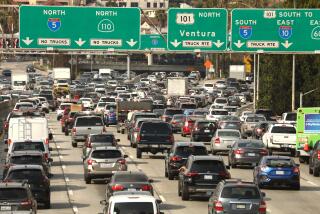Technology Swerves to Dodge Gridlock
- Share via
TROY, N.Y. — Picking up doughnuts on the way to work recently, George List slid back into the driver’s seat and heard a voice from the cup holder suggest an alternate route.
The car wasn’t talking, exactly. The voice came from a small computer nestled in the holder that links his car to 200 other vehicles in the area. Data from all the vehicles -- where they are, how quickly they move -- are processed to create snapshots of area traffic patterns.
The system had detected a bottleneck ahead and quickly calculated a faster route.
“I said, ‘Oh, that’s interesting, it changed its mind when I was doing something else,’ ” he said.
List took the machine’s advice.
He later saw the traffic jam -- at a distance, from another road.
List, head of Rensselaer Polytechnic Institute’s Center for Infrastructure and Transportation Studies, co-directs a federally funded project examining a potential high-tech solution to highway congestion. Traffic is tracked through Global Positioning System devices in cars that are connected to one another wirelessly. Drivers participating in the pilot project act as highway probes, receiving continual feedback from in-car computers intoning commands such as “Just ahead, turn right.”
“They’re benefiting from each other being eyes and ears in the network,” List said.
The project is one of many “smart highway” initiatives that rely on technology such as traffic sensors and roadside cameras. This experimental system, with its automatic updates, would be a bit smarter.
By all accounts, traffic in America is getting worse.
Once the scourge of big cities alone, congestion is now common in smaller cities and suburbs. Studies have found more bottlenecks nationwide and more time wasted in traffic as commuters travel greater distances.
Building new lanes can help. But for decades, state and federal transportation authorities also have pursued the cheaper option of trying to make traffic flow more efficiently.
The idea is to provide drivers with up-to-date traffic information through dedicated AM radio stations, electronic traffic signs, 511 numbers or, more recently, websites and cellphones. Traffic information is often gleaned from sensors in the pavement or from pole-mounted cameras.
This wireless project, headed by Rensselaer and funded by a $1.3-million grant from state and federal highway officials, focuses on information collected from commuters on weekday mornings. In February, 200 volunteers who commute daily were lent a GPS unit and a handheld computer linked to a central server.
Drive-time information is sent each minute from each vehicle to the server, which forms a picture of traffic flow around a 40-mile radius. Speed is calculated by tracking progress between virtual checkpoints, and the wireless computers send updates.
Each monitor displays a map, but there’s no need to look at it, thanks to a synthesized voice that sounds like a cross between a robot and the AOL “You’ve got mail” guy.
“The driver does not have to look at that dinky little screen while they’re driving,” said Alixandra Demers, a graduate student working on the project.
The experiment runs through May 15. Depending on results, the school may conduct a second, larger test.
William “Al” Wallace, director of research for the center, said the Advance Traveler Information System could be particularly attractive for small and midsize cities plagued by rush-hour bottlenecks. Setting it up would be cheaper than investing in a series of pole-mounted cameras or road sensors.
The idea behind the system will be familiar to anyone who has ever used OnStar or other directional devices that rely on GPS units. The added element is that it could sense a delay if, say, a truck was overturned across the designated route, using information from cars ahead moving slowly.
GPS is one of several technologies being studied by transportation officials and private companies looking to update traffic systems, said Neil Schuster, president of the nonprofit Intelligent Transportation Society of America. AirSage, an Atlanta-based company, has developed a system that uses cellphones as anonymous “traffic probes.” Its first client will be the Virginia Department of Transportation, which will use it in Norfolk this summer, said Cy Smith, AirSage’s president and chief executive officer.
Schuster said the auto industry was looking closely at federally dedicated spectrum space that could host a wireless network for cars.
Drivers in larger cities such as San Francisco and Houston can already check the Internet for color-coded traffic congestion maps.
Acura’s 2005 RL model features a navigation system that provides real-time traffic updates for 20 major cities; traffic data are aggregated from local police, transportation departments and other sources, and transmitted to the cars via XM radio satellites.
“The next big chapter in road development in the U.S. is, ‘How do you take all of these roads and connect them electronically?’ ” Schuster said.
The Electronic Highway is barely plugged in, but aspects of it have stirred controversy. Privacy advocates worry about the misuse of information collected from roadside cameras, electronic toll tags and “black box” computer chips, which store information on speed and seat-belt use. On-board GPS units have been used by police to track stolen cars, by businesses to pinpoint fleet trucks and, more ominously, by stalkers.
Rensselaer’s List notes, though, that users who don’t want to be tracked can simply switch off the GPS unit.
The big question: How much are people willing to spend to avoid sitting in traffic?
List figures that to make the system effective, about 10% to 15% of drivers in a given area would need to participate. Purchased separately, the devices cost about $1,000.
A mass-produced device would presumably cost less, particularly if the technology were included in on-board GPS devices or pocket PCs.






